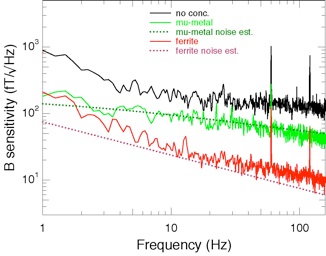





Materials with high magnetic permeability tend to collect magnetic flux lines. This property can lead to a magnetic field amplification in the gap between two high permeability structures. Examples of this effect are illustrated in the picture below for triangular and rod shaped flux concentrators. Locating a magnetic sensor between the concentrators can then allow a sensitivity enhancement relative to the external magnetic field. Flux concentrators have previously been combined with a wide variety of magnetic sensor technologies, including Hall effect, magnetoresistive, and SQUID sensors. Here we study the effects of adding flux concentrators to a miniature SERF atomic magnetometer. The magnetometer utilizes a 1 mm3 microfabricated rubidium vapor cell and a Vertical-Cavity Surface-Emitting Laser (VCSEL) light source.

Parts (a) and (b) show numerical calculations of the magnetic flux lines and field density (false color) of a uniform external field in the presence of triangle and rod shaped flux concentrators. (c) shows a photograph of mu-metal triangle concentrators around the microfabricated Rb vapor cell, and (d) shows a close-up photograph of the vapor cell with ferrite rod concentrators.
We have worked with two types of concentrators, mu-metal triangles and MnZn ferrite rods. Mu-metal is a high permeability nickel-iron alloy commonly used in magnetic shields, and MnZn is a magnetically soft ferrite commonly used in inductor cores. Photographs of the concentrators are shown above. Both types of concentrators amplified the magnetic field at the vapor cell by about 20 times. We might then expect an improvement in magnetic field sensitivity by up to a factor of 20 compared to the sensitivity without concentrators; however the sensitivity improvement is limited by thermal magnetic noise introduced by the concentrator material. Magnetic field sensitivities achieved with and without the concentrators are shown in the figure below, along with calculated predictions for the thermal magnetic noise generated by the mu-metal and ferrite.
The mu-metal concentrator sensitivity is limited by Johnson noise (thermal motion of the electrons in the metal), while the ferrite concentrators achieve a better sensitivity because MnZn has a much lower electrical conductivity and thus negligible Johnson noise. The ferrite is still subject to thermal noise from magnetic domain fluctuations, which limit the sensitivity to 75 fT/Hz1/2 at 1 Hz, improving at higher frequencies with a 1/f1/2 dependence. This allows our sensor to reach a magnetic field sensitivity of 10 fT/Hz1/2 for measurement frequencies above 100 Hz.
References:
-
W.C. Griffith, R. Jimenez-Martinez, V. Shah, S. Knappe, and J. Kitching. “Miniature atomic magnetometer integrated with flux concentrators.” Appl. Phys. Lett., 94, 023502, 2009.

Magnetic field sensitivity versus frequency without concentrators (black), with mu-metal triangle concentrators (green), and with ferrite rod concentrators (red). The dotted lines show the expected limits on sensitivity from thermal magnetic noise in the concentrator material.